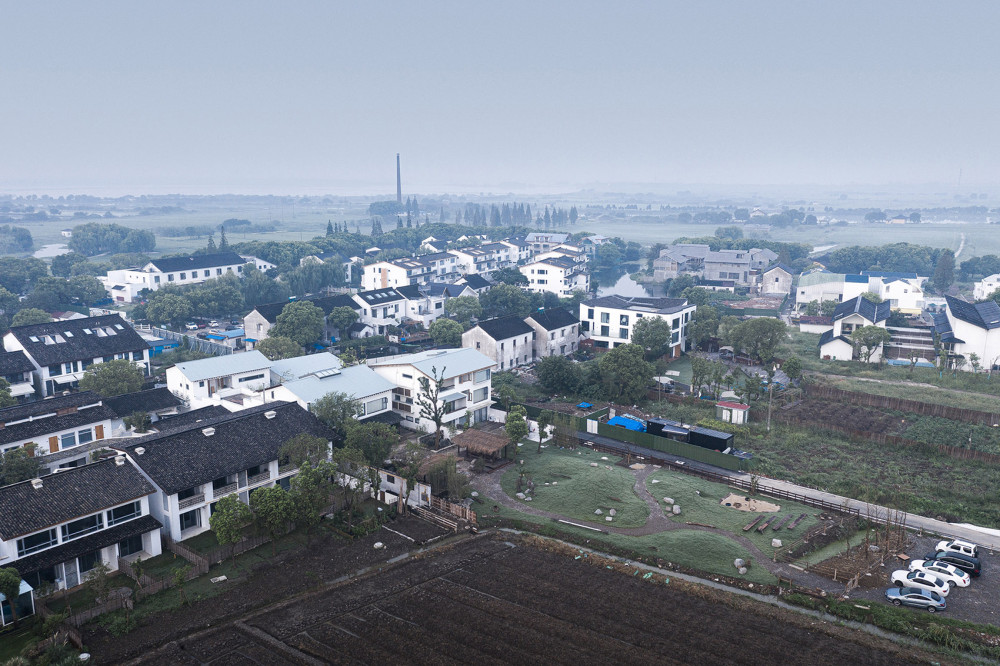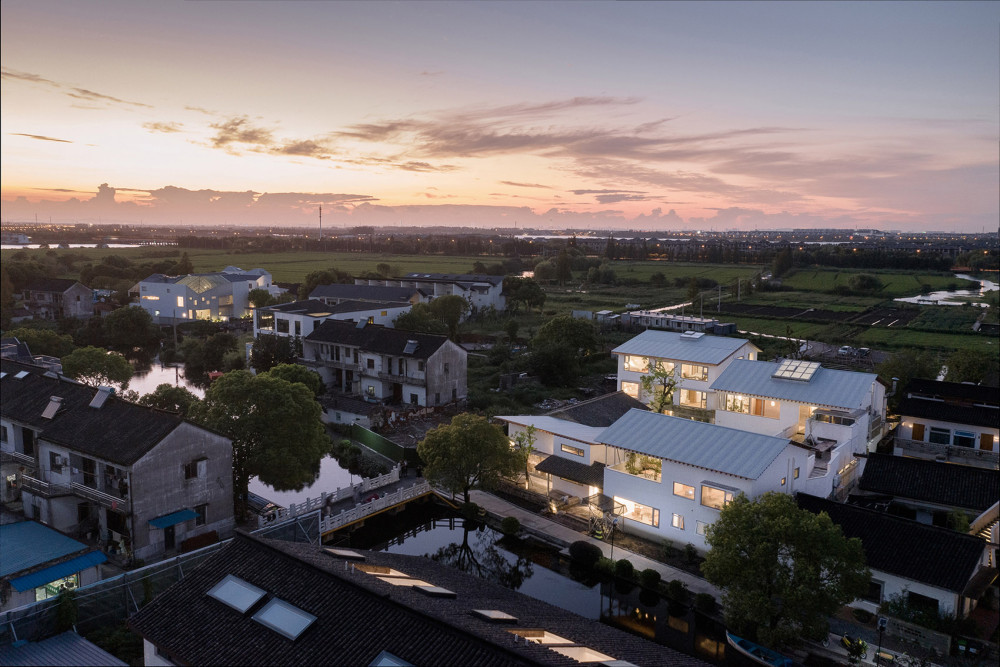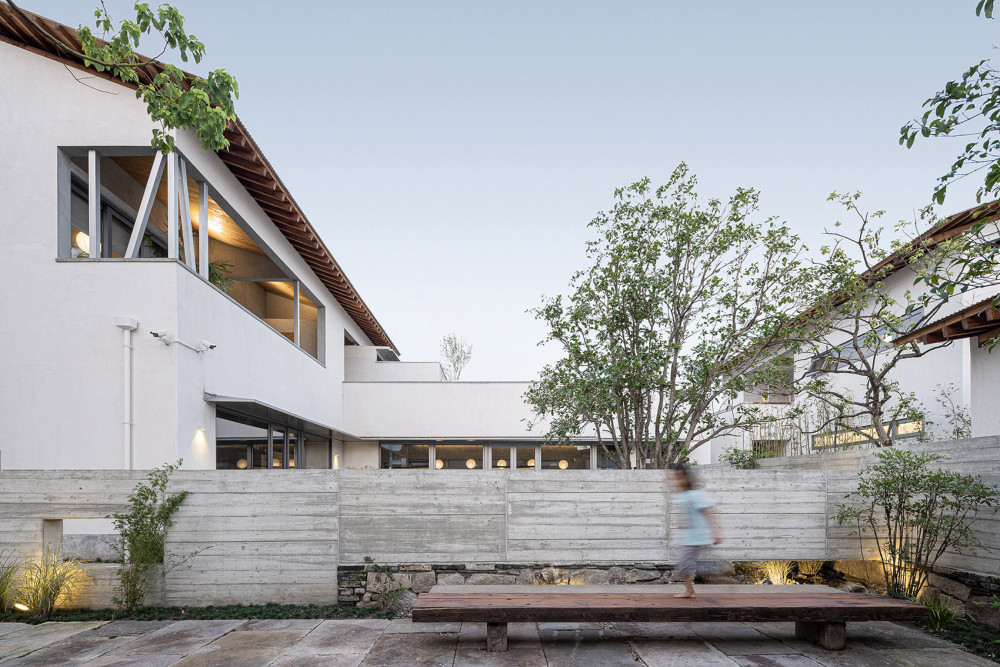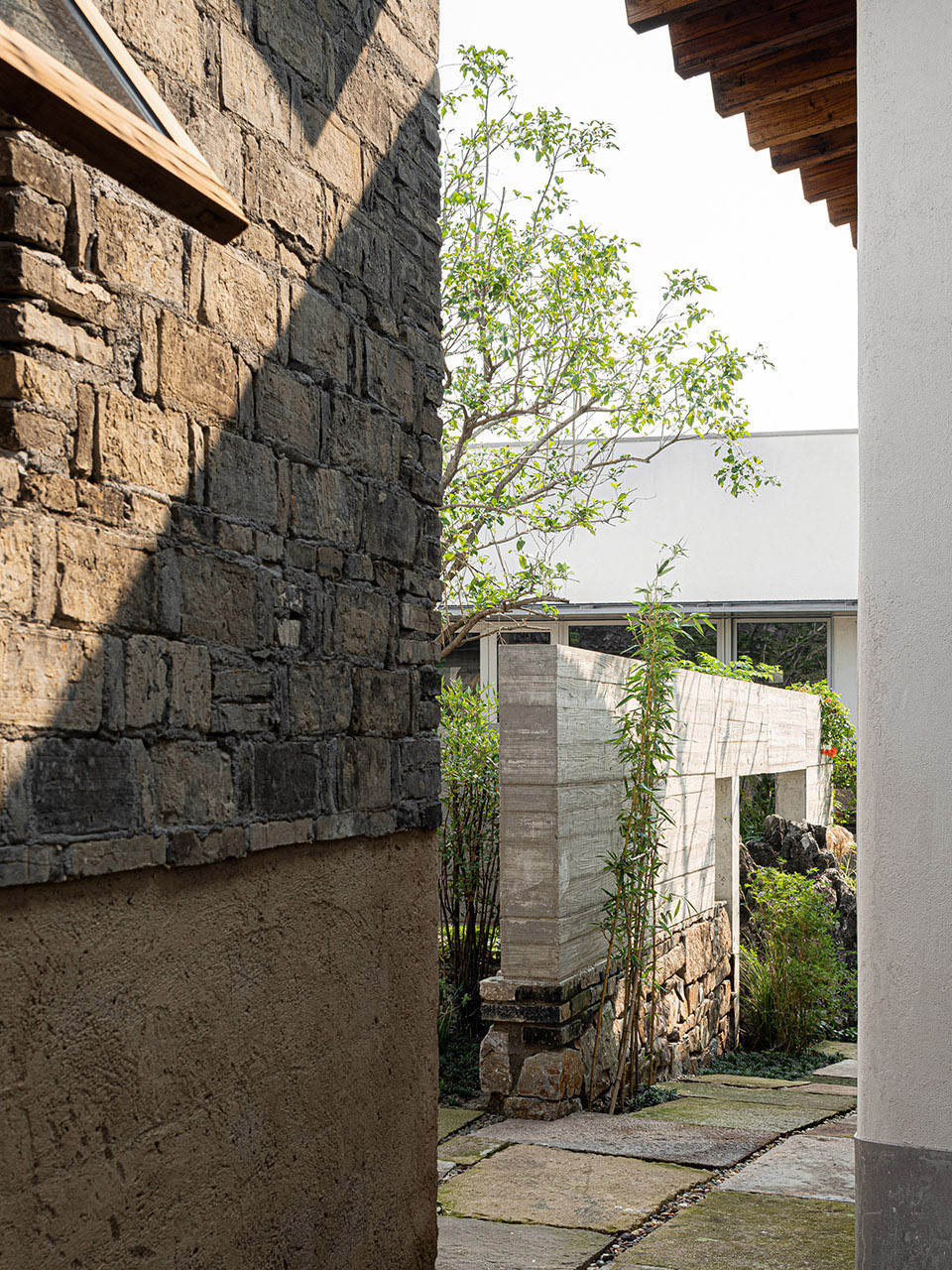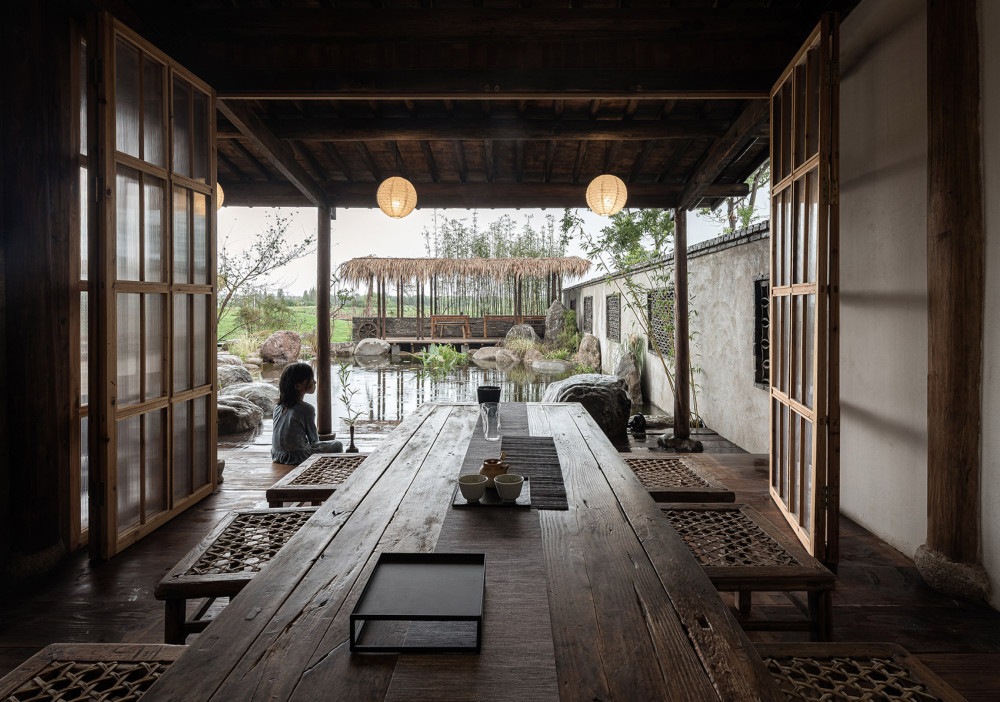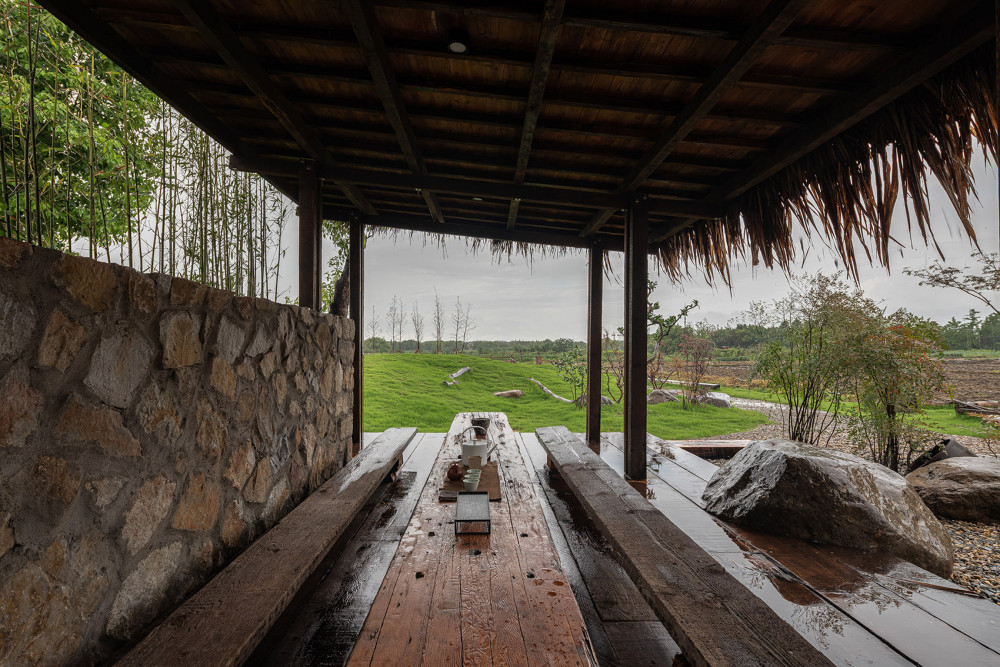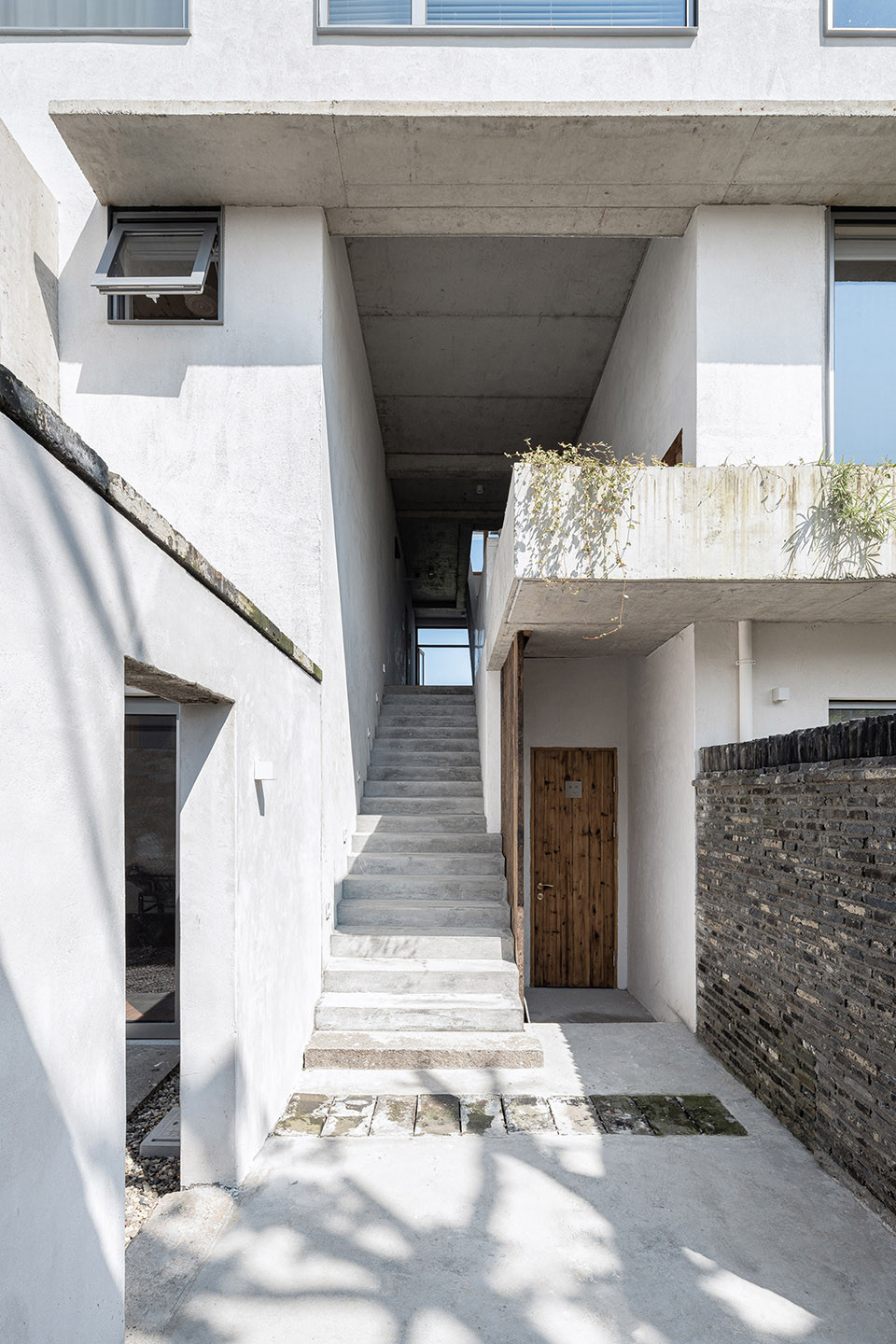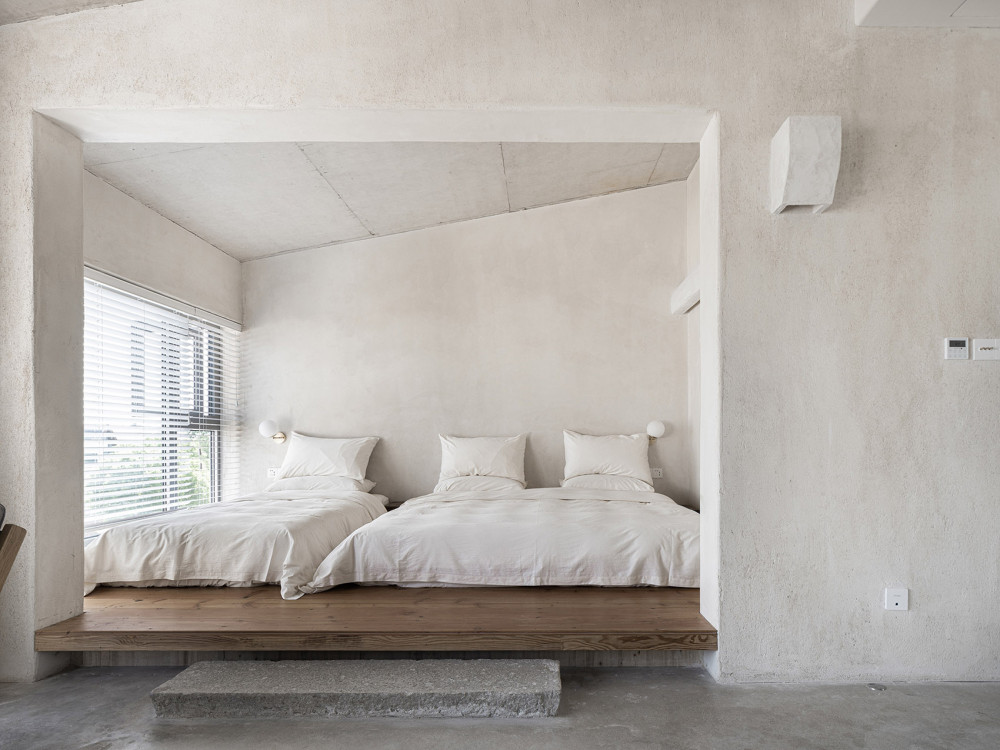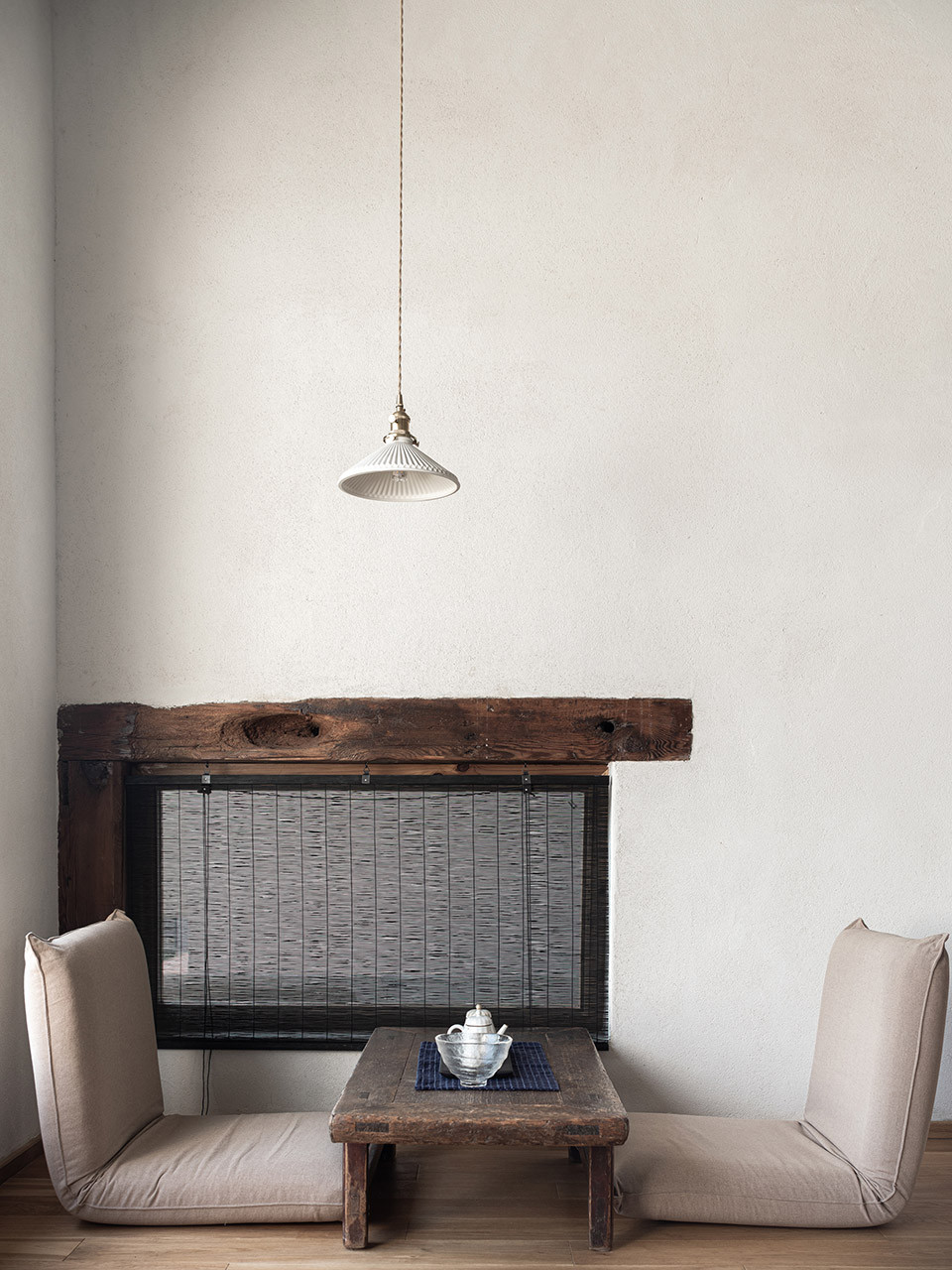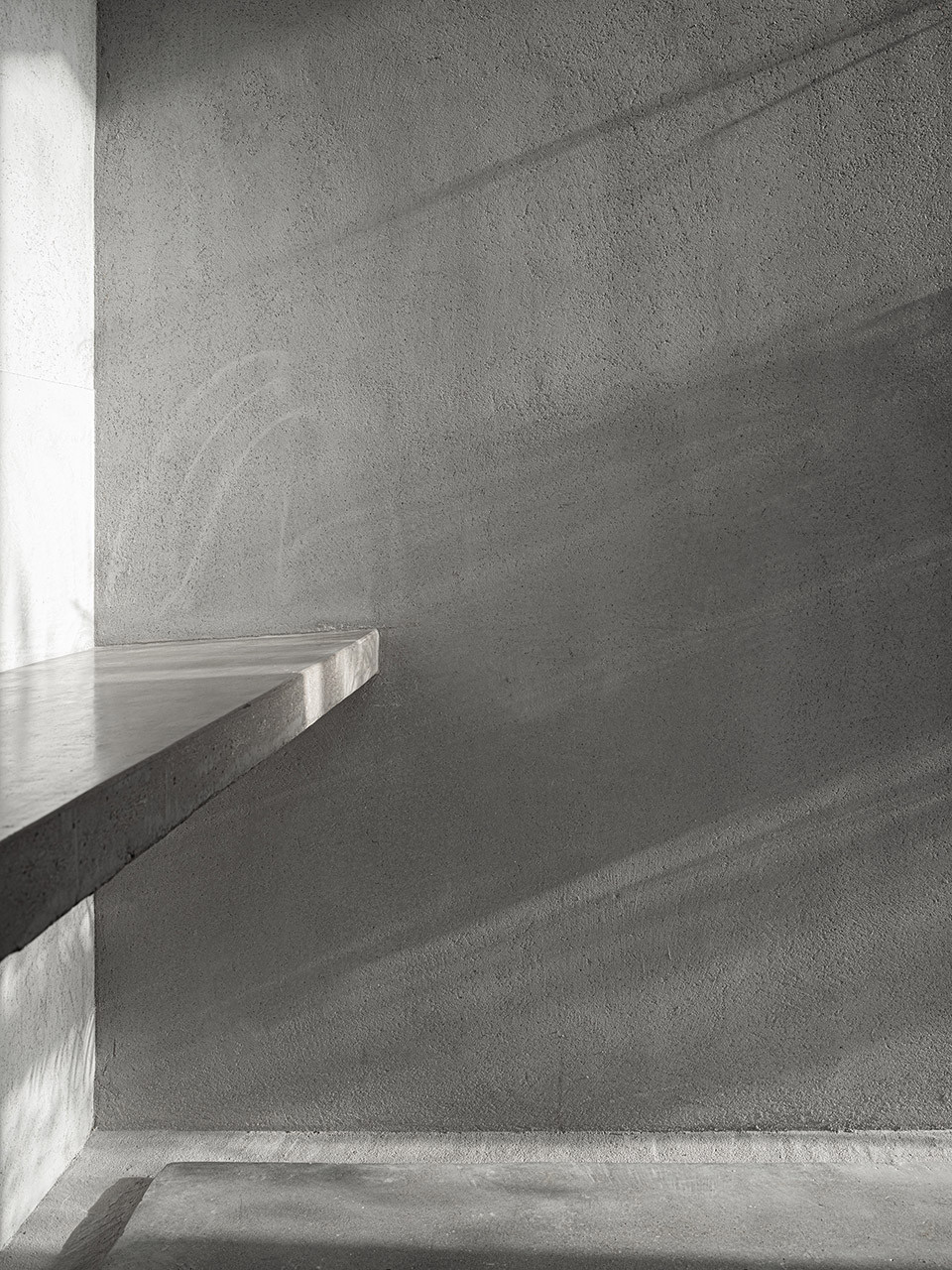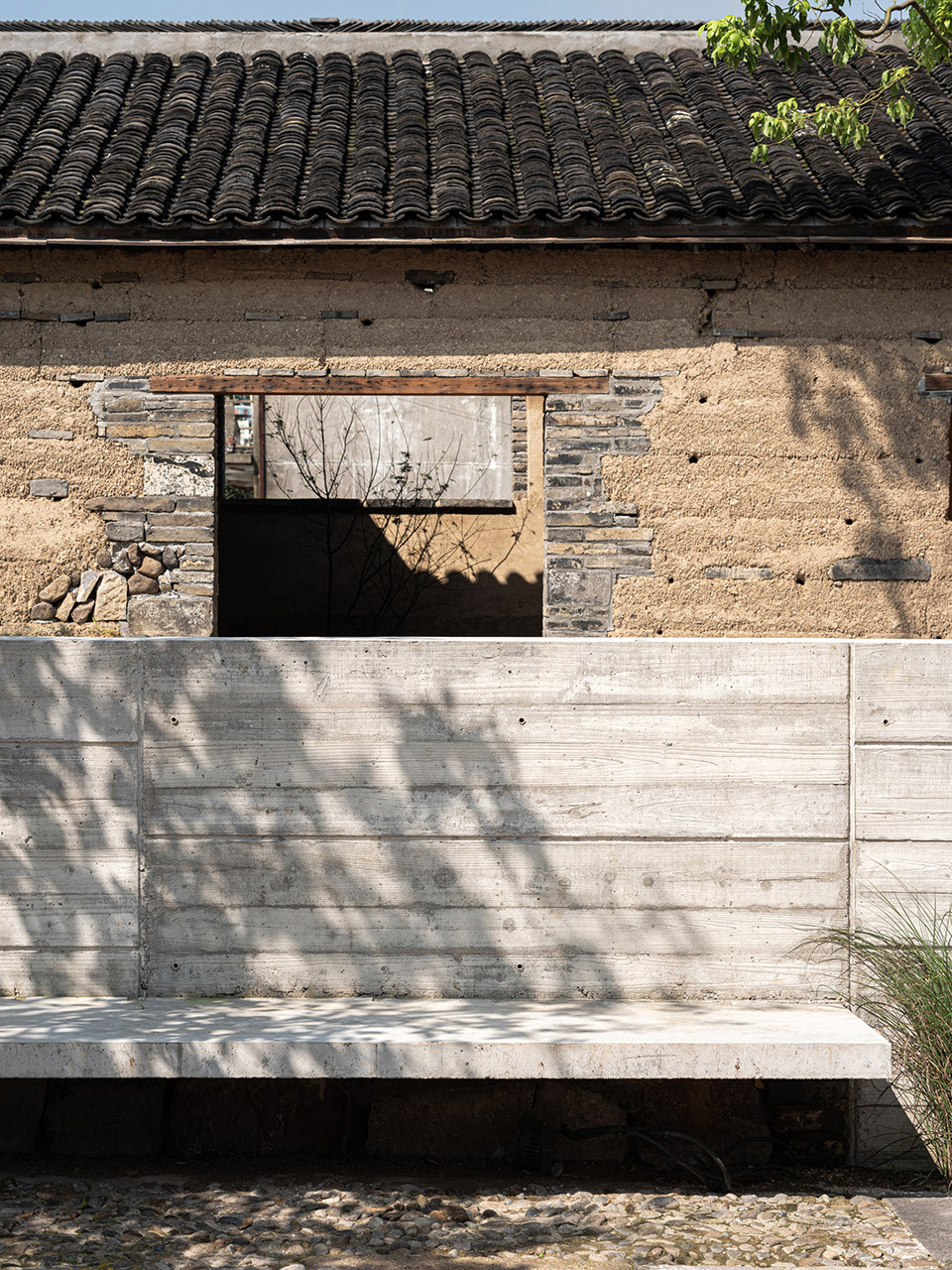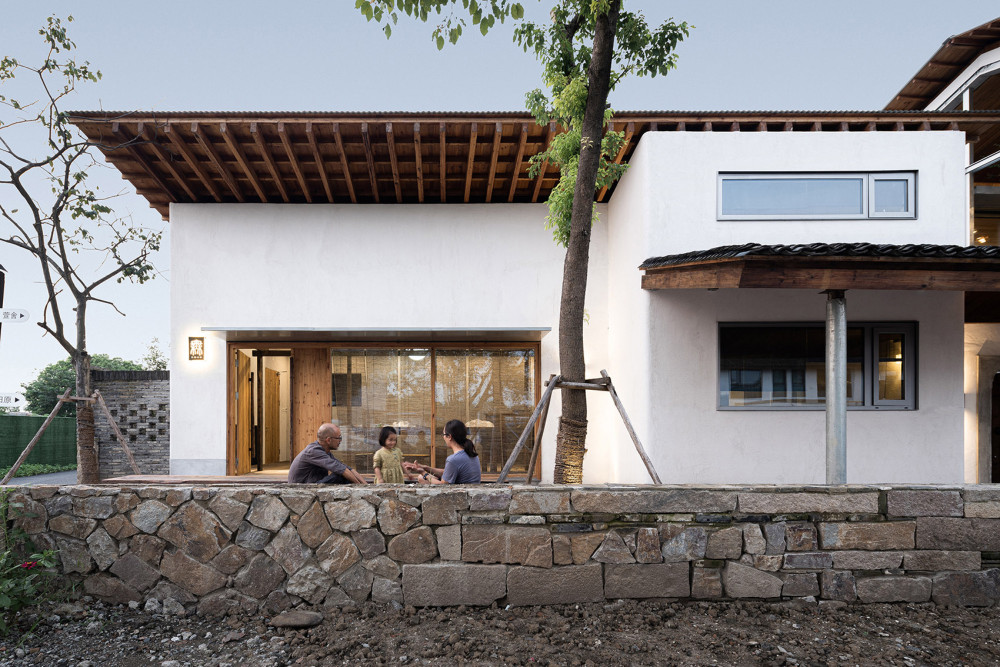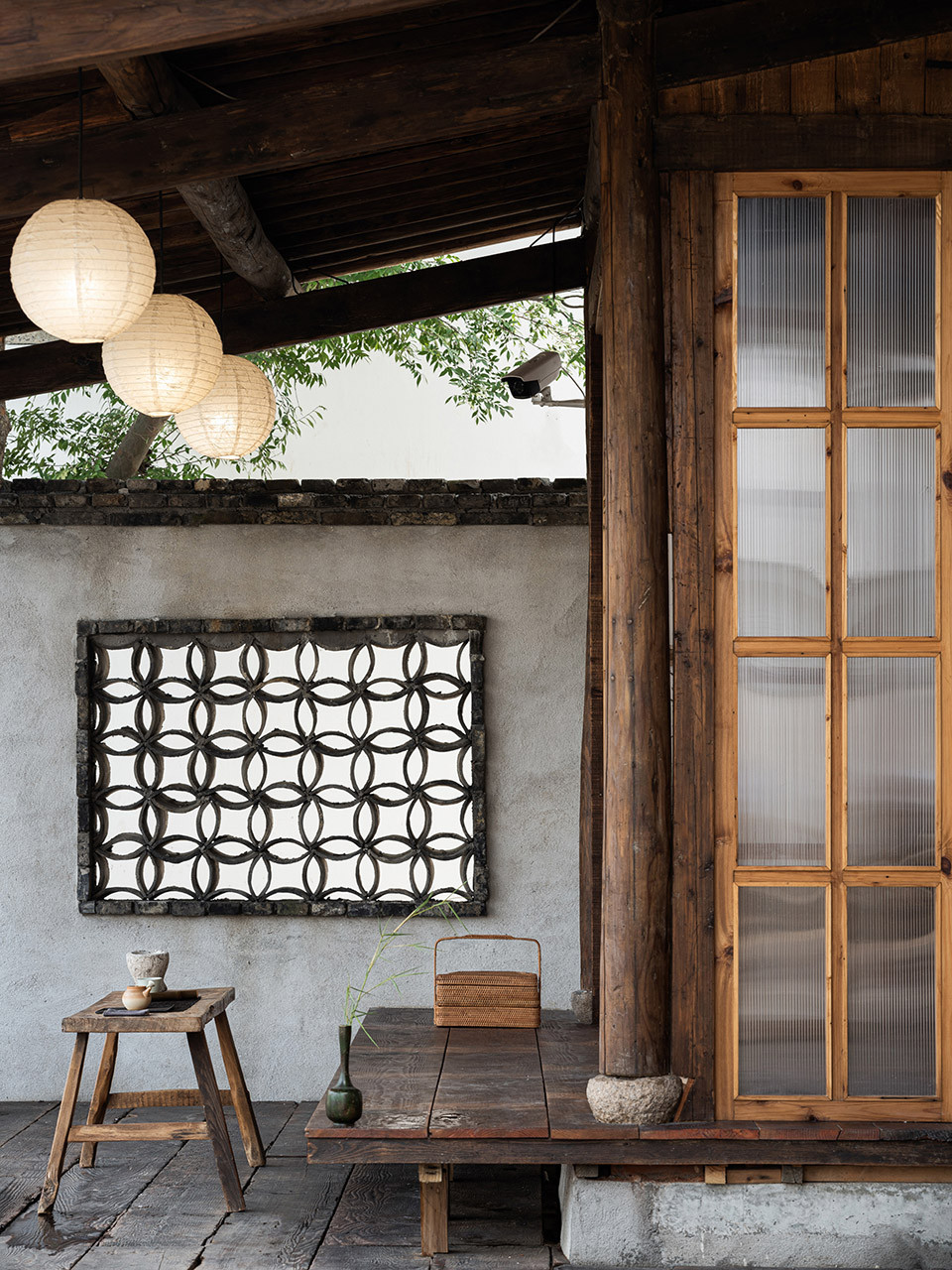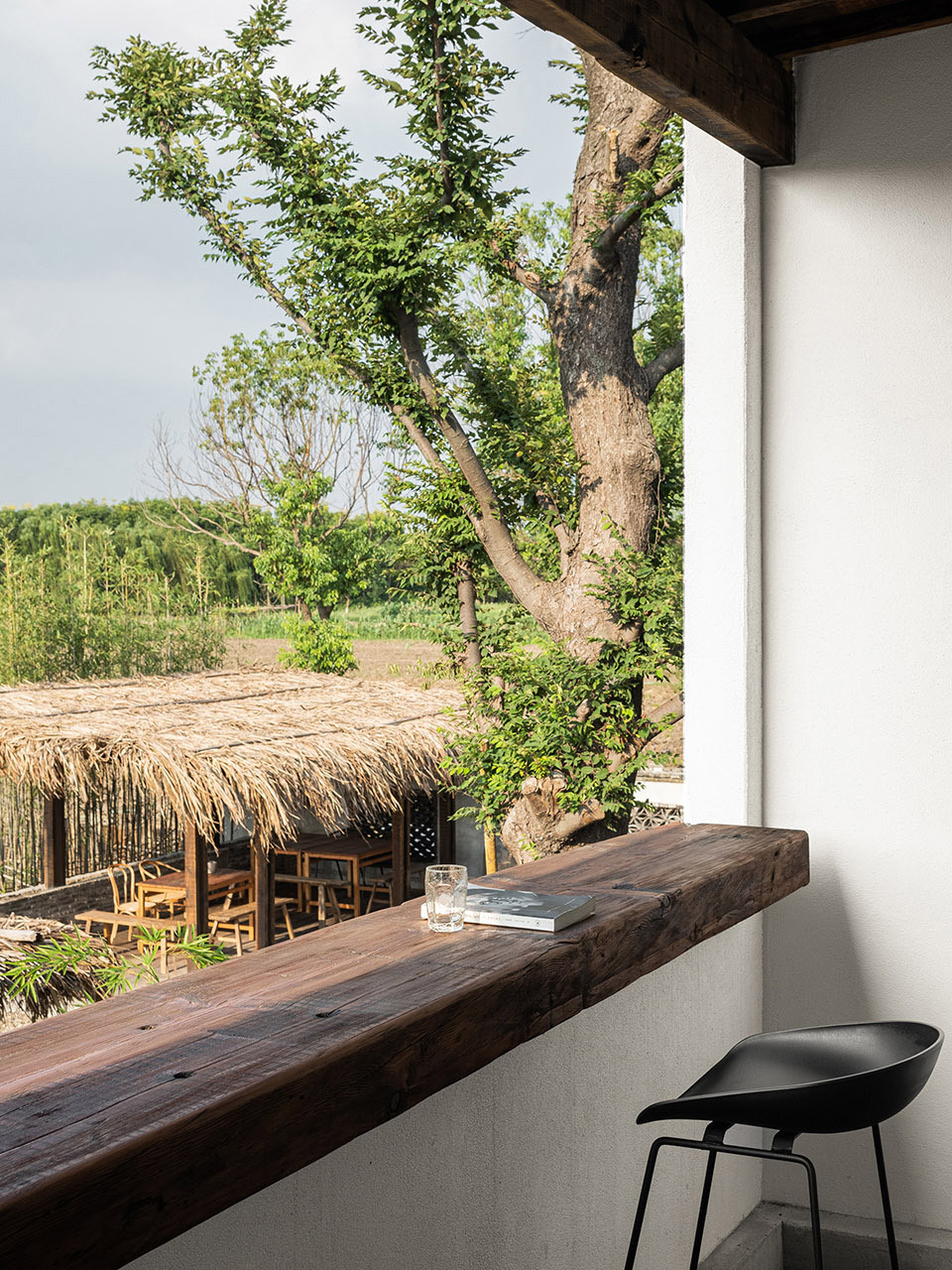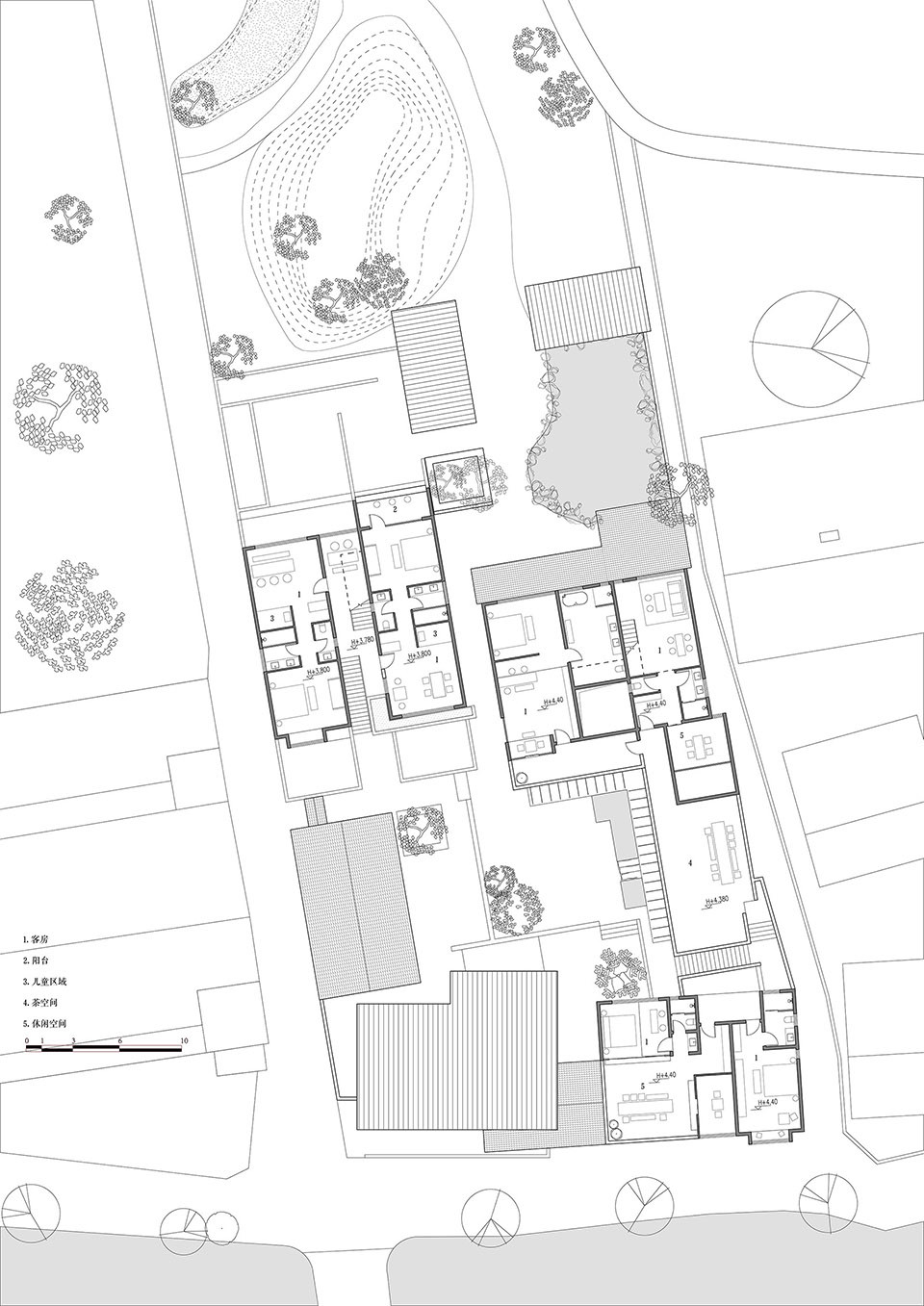本帖最后由 大形设计 于 2019-12-3 10:37 编辑
场地 The Site: 1100㎡ 无象归园位于昆山锦溪镇计家墩村,与青浦商塌镇一河相望。自然水系将整个村子环抱,与淀山湖、澄湖相连, 村子四面被农田环绕。计家墩村约130户村民,房子依河而建,前院后屋,白墙灰瓦。基地位于村子南北主路的北面东侧,共有四个宅基组成,南侧临河,北面连接农田,占地约1100平方米。
WUSH Inn is located in a small village called Jijia, which is embraced by natural river systems and endless farmlands. There are about 130 villagers living in Chinese traditional houses near by the river. The site in the northeast of the main road of the village that is consisted of four homesteads, facing river to the south and farmland to the north, covering 1100 m2.
▼村落鸟瞰,aerial view of the building ©邵峰
▼隔岸相望,view to the building through the lake ©邵峰
项目 The Project 计家墩作为乡伴文旅第一个理想村,吸引着一批向往乡村生活的城市人来到村里。目前已有11家主题民宿酒店开业,木工房、陶艺坊、自然农场、乡村书店、研学基地、正念禅修中心等业态也相继对外开放。
As the first ideal village of Xiangban Culture & Tourism, Jijia Village has attracted a large group of city dwellers who yearned for living in a rural lifestyle. Until now there are eleven theme Inns have already opened. Others including wooden art studio, pottery workshop, nature farm, village bookshop, research center, and meditation center, etc, will be opening soon.
▼黄昏鸟瞰,aerial of the building in the dusk ©邵峰
无象归园定位为“新乡村生活空间”。功能包括杂货铺、接待大厅、田园餐厅、茶空间、读经房、乡村创客空间、以及10间客房,总建筑面积约1200平方米。
WUSH Inn is positioned as ‘new rural life space’, including grocery, reception hall, pastoral restaurant, tea space, scripture room, rural innovation space and 10 guest rooms, with a total area of 1200㎡.
▼总体鸟瞰,overall view ©邵峰
▼露台与庭院,terrace and courtyard ©邵峰
设计 Design
计家墩原有的村落肌理、空间尺度以及中国传统院落的布局结构是项目布局构思的出发点。在30米*40米左右的用地内布置了南北各两栋,东西各一栋房子,形成传统的合院结构。通过对基地周边的道路、水系、农田以及南向主入口等要素的梳理:结合六栋房子的功能、体量、朝向、日照、尺度等因素进行二次布局,试图在南北轴线安排两个主院落。
Design of this project stems from studying of existing village composition, spatial scale and Chinese traditional yard layout. In a site of 30 meters * 40 meters, the layout of six houses forms a traditional courtyard. By sorting out the surrounding roads, water systems, farmland and the main entrance to the south: combining the functions, mass, orientation, sunlighting, scale, and other factors of the six houses, we generated a second layout that places two courtyards on the north-south axis.
▼院落布局,layout of the courtyards ©大形设计
▼二层平台看南院,view of the courtyard from the second floor ©邵峰
在“南院”,通过“T”型的木纹清水混凝土墙体界定了三个不同标高,不同属性,不同尺度的“次院”;每个“次院”通过台阶及坡道与南门、西门、东门、北院发生四种不同空间尺度的连结,完成了“意犹未尽,曲折有情”的空间意向;
In the “South Courtyard”, a T shape bare concrete wall divides the flat into three secondary courtyards with different elevations, functions and dimensions; each of these three courtyards connected with south gate, west gate, east gate and the “North Courtyard” with stairs and ramp, creating a meandering walking experience.
▼庭院与高差,courtyard divided with different elevations ©大形设计
▼分割院子的清水混凝土墙,concrete wall divides the courtyard ©邵峰
▼连接院落的街巷,alleys connect to the courtyard ©邵峰
“北院”是作为主体建筑与田野自然空间的过度,通过两个方向的“亭子”界定了“内与外”,并将这种“虚实”向自然无限延展。
The North Courtyard is a transition between the main building and nature. Two canopies of different orientations form a gray space that blurs the boundary between interior and exterior.
▼水边茶室,tea house beside the water ©邵峰
▼从茶室看向自然的亭子,view to the natural pavilion from the tea house ©邵峰
▼亭子内外,in and outside the pavilion ©邵峰
材料 Material 无象在设计阶段与实际完成之间最大的不同是材料以及材料的质感。在墙面材料的选择上,我们和专业厂商进行了多次的实验,外墙选择了粗糙肌理的“本色无机砂浆”。室内“无机砂浆”采用压光处理;
The main difference between design stage and the final completion is the material types and texture. In the selection of wall material, we have carried out many experiments with professional manufacturers and eventually we decided to use self-coloured inorganic mortar for the exterior walls and press polished inorganic mortar for interior walls.
▼5#楼南立面,elevation of the #5 building ©邵峰
▼客房区域的楼梯,staircase in the guest room area ©邵峰
清水混凝土(加固化剂并研磨抛光)作为地面,墙面,台面的材料,让质感的“不能确定”变得的自然而然;
Bare concrete is used as the material of floor, wall and countertop after grinding and polishing. The handmade texture makes the “uncertainty” more natural.
▼细部质感,material details ©邵峰
古法夯土墙被台风暴雨洗出了“泥土的时间”;老石板,老青砖,老木头的使用让空间变“重“,让时间“凝固”。
The loam wall, made with ancient method, shows the marks of time after washing by rainstorm. The use of old slate, old blue brick and old wood made the space look sublime and timeless.
▼夯土房,rammed earth house ©邵峰
树石 Tree & Stone 树是有生命的。当找了三个月的17米高的老香樟树被吊到夯土房前面的瞬间,我意识到整个院子活了。
Trees could bring energy. When a 17-metre tall camphor tree was planted in front of the rammed earth house, the entire courtyard became alive.
▼南院树木,trees in front of the rammed earth house ©邵峰
石头是自然的。4块来自广西西部的自然山峰石,都是天地的造物。场地高差基本平整完成,她们就进场了。然后与院子一起生长。
Stones are natural creatures. We found 4 natural mountain stones from west GuangXi Province. They arrived after smoothing the level, and then live with the yard together.
▼南院自然山峰石,natural stones in the courtyard ©邵峰
使用 Usage “有之以为利,无之以为用”。设计营造完成了大部分的“有无”。在自己构想的“有无”里去感受:天地玄黄,日月盈昃,寒来暑往,闰馀成岁 。用以反观设计。
‘Existence for convenience, and inexistence for creating.’ The design process finish most part of ‘existence or in existence’. We experience the passing of time in such an environment, which will reflect how the design is.
▼入口小院,entrance courtyard ©邵峰
▼条石、木板等休息空间,spaces for rest ©邵峰
▼面朝田园的阳台和儿童娱乐空间,balcony facing the farmland and outdoor space for children to play ©邵峰
建造 Construction 在无象归园三年建造的最后三百天里,我几乎每天都在工地和师傅们一起,既是投资人,又是项目经理、采购、设计师、包工头、还做小工……这过程让我更加坚信图纸的重要性,也让我明白了图纸仅仅是“图纸”,在现场不停反复的判断与决定同样有着重要意义。这是一个已从事15年商业设计的建筑师的选择。
In the last three hundred days of this three-year journey, I spent almost every day with workers on site. I was the investor, the project manager, buyer, designer, contractor, and worker myself. This process made me more convinced of the importance of drawings, and makes me understand that drawings are just “drawings”. It is also necessary to judge and make decisions repeatedly on site to create a meaningful space. This is the decision of an architect with fifteen years of commercial design experience.
▼模型,models ©大形设计
▼一层平面,first floor plan ©大形设计
▼二层平面,second floor plan ©大形设计
▼三层平面,third floor plan ©大形设计
▼南立面,south elevation ©大形设计
▼北立面,north elevation ©大形设计
项目名称:无象归园
项目地点:昆山市锦溪镇南首计家墩村
项目类型:新乡村生活空间
建筑/室内/景观设计:大形设计
主持建筑师:邢永恒
建筑师:皮黎明、林为依、蔡泽曦、黄浩、钟佳吟、谢豪洲、郑盛园
施工匠人:姚秀军、石教明、张景兵、洪芳平、凌根荣、杜平红、胡德祥、刘之明
结构设计:李海乐、赵红郎
室内设计:郑盛园
机电设计:许建兵、李雪咏
结构类型:轻钢网模/砖混/古法夯土
建筑材料:无机砂浆、清水混凝土、力士伯乐(混凝土固化剂)、波形金属瓦、小青瓦、自制茅草、老石板、老青砖、老木头。
业主单位:昆山无象归园酒店管理有限公司
施工单位:浙江正合建筑网模有限公司
建材商品牌:
1. 浙江正合网模
2. 美国力士伯乐/安斯福妙乐混凝土固化剂
3. 瑞士吉博力卫浴
4. 铃鹿复合建材
5. 沐祥门窗
建筑面积:1200.0㎡
设计时间:2016.05-2019.08
建设时间:2016.11-2019.08
摄影:邵峰
摄影师网站:http://www.sfap.com.cn
|
无象归园-大形设计.rar
16.86 MB,下载次数:72
|

